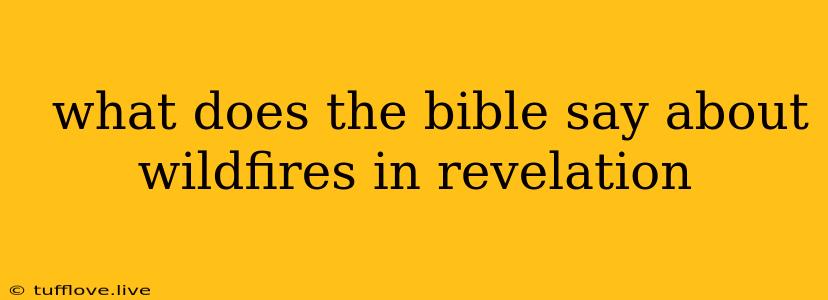The book of Revelation, the final book of the New Testament, is a complex and multifaceted text that has sparked countless interpretations and debates throughout history. While the book focuses primarily on the final battle between good and evil, culminating in the establishment of God's kingdom, it also contains vivid imagery and symbolism that can be difficult to decipher. One such element that has captured the attention of many is the depiction of natural disasters, particularly wildfires. While the text does not explicitly mention wildfires, some scholars and interpreters believe that certain passages can be understood as alluding to this phenomenon, offering insight into the potential consequences of sin and the ultimate triumph of God's justice.
The Role of Fire in Revelation
Throughout the book of Revelation, fire appears repeatedly, often serving as a powerful symbol of judgment, purification, and transformation. In the early chapters, fire is associated with the wrath of God, as seen in the seven seals, the seven trumpets, and the seven bowls of judgment.
The Seven Seals
The opening of the first six seals in Revelation 6 reveals a series of judgments that bring destruction and chaos upon the earth. The opening of the sixth seal, for instance, depicts a great earthquake, the sun turning black, the moon becoming like blood, and the stars falling from the sky (Revelation 6:12-13). This imagery of cosmic upheaval has been interpreted by some to symbolize a catastrophic event, potentially involving wildfires.
The Seven Trumpets
The seven trumpets in Revelation 8-9 are another series of judgments that bring further devastation. The second trumpet unleashes a fiery mountain, which is cast into the sea, causing a third of the sea to turn to blood and killing a third of all living creatures (Revelation 8:8-9). This imagery of a fiery mountain falling into the sea could be interpreted as a reference to a massive wildfire, potentially causing widespread destruction and pollution.
The Seven Bowls of Wrath
The final judgments in Revelation 16 are depicted through the seven bowls of God's wrath, each pouring out a unique and destructive plague. The third bowl brings a scorching fire upon the rivers and springs of water (Revelation 16:8-9), while the fourth bowl causes a scorching heat to burn people with fire (Revelation 16:8-9). These descriptions of burning rivers and scorching heat may be symbolic of the immense destruction that wildfires can cause, leading to widespread suffering and death.
Interpreting the Fire
While these passages do not explicitly mention wildfires, the imagery of fire and destruction is prevalent throughout Revelation. The use of fire as a symbolic representation of God's judgment is a common theme in both the Old and New Testaments. It is important to remember that Revelation is not a literal prophecy of future events but rather a symbolic message that seeks to inspire hope and faith in God's ultimate victory over evil.
The Fire of God's Wrath
The fire depicted in Revelation can be interpreted as a representation of God's wrath against sin and injustice. Just as fire purifies and consumes impurities, so too does God's judgment cleanse the world from evil and usher in a new age of righteousness.
The Fire of Transformation
Revelation also emphasizes the transformative power of fire. While it may be associated with destruction, fire can also be a symbol of renewal and purification. This is evident in the imagery of the new heavens and new earth described in Revelation 21, which are cleansed by fire, becoming a dwelling place for God and his people.
The Meaning of Wildfires in the Book of Revelation
While wildfires are not explicitly mentioned in Revelation, the use of fire as a symbol of judgment, purification, and transformation offers insight into the potential consequences of sin and the ultimate triumph of God's justice. The book of Revelation serves as a reminder that God is ultimately in control, and that even in the midst of suffering and destruction, his love and faithfulness endure.
A Call to Repentance
The imagery of fire in Revelation serves as a call to repentance and a warning against the dangers of sin. Just as wildfires can spread uncontrollably, consuming everything in their path, so too can sin destroy lives and communities.
Hope for the Future
Despite the depictions of judgment and destruction, Revelation ultimately offers a message of hope. The book concludes with the promise of a new heaven and a new earth, a world free from sin and suffering, where God will dwell with his people. This vision of a renewed creation offers comfort and encouragement, reminding us that even in the darkest of times, God's love and faithfulness endure.
Conclusion
The book of Revelation is a complex and multifaceted text that has inspired countless interpretations and debates. While the book does not explicitly mention wildfires, the use of fire as a powerful symbol of judgment, purification, and transformation offers insight into the potential consequences of sin and the ultimate triumph of God's justice. The imagery of fire in Revelation can be understood as a call to repentance and a warning against the dangers of sin, but it also serves as a reminder of God's love and faithfulness, ultimately leading to a vision of a renewed creation free from suffering and injustice.
